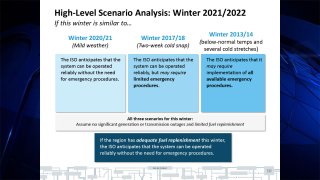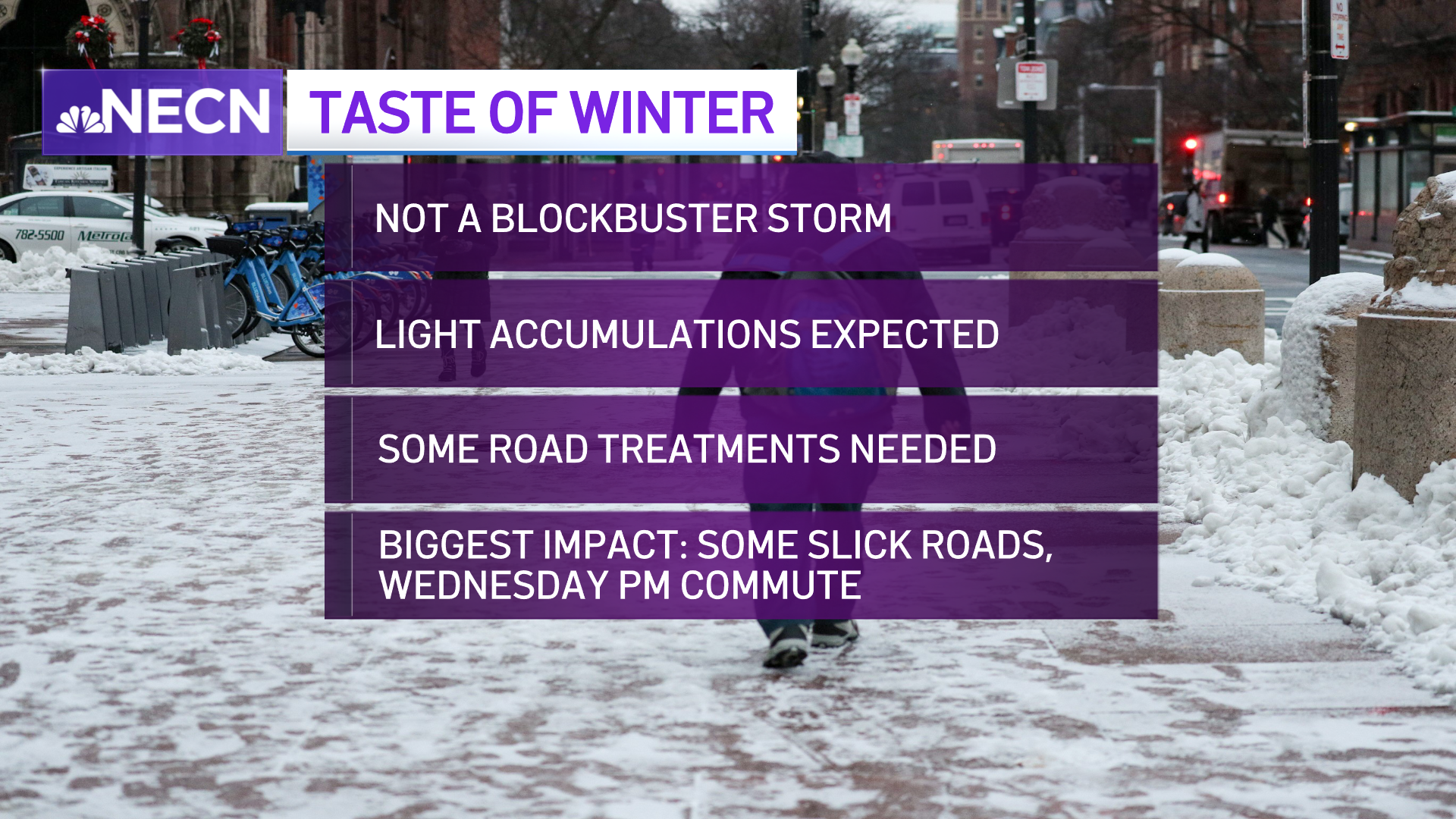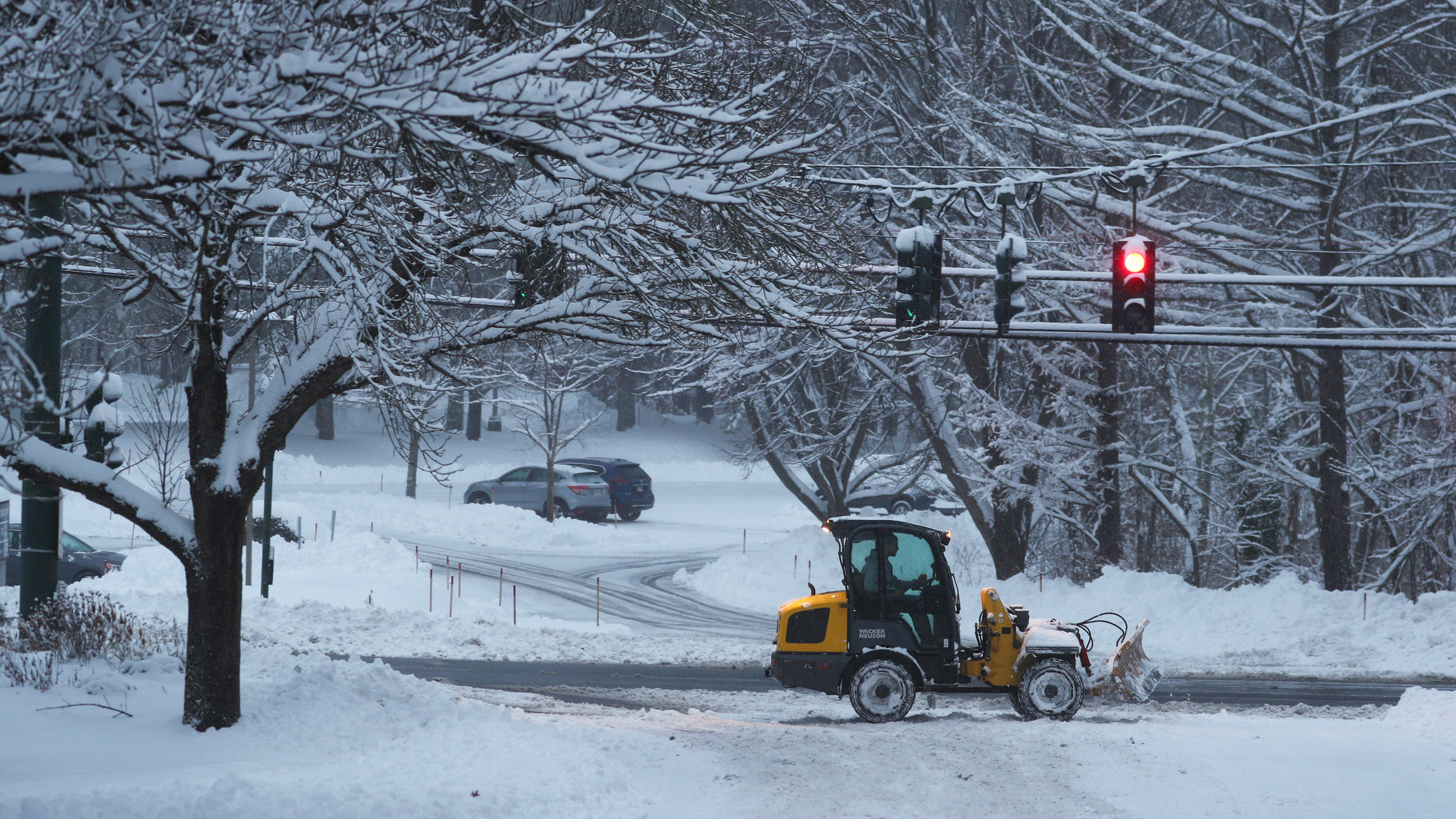
Electric grid operators expect to be able to keep the lights on in New England this winter. But having come close to a major problem during a costly cold snap here four years ago and watching the recent struggles of power systems in California and Texas, ISO-New England is also doing more to highlight the risks the region's power system faces as temperatures drop.
ISO-NE expects that demand among the 14 million electric customers in New England will peak this winter at 19,710 megawatts under average winter weather conditions of 10 degrees and as high as 20,349 MW if average temperatures drop below 5 degrees. The winter demand forecast, which is about 2% lower than the forecasted peak demand for last winter, is based on a National Oceanic and Atmospheric Administration outlook that projects a milder than average New England winter.
Demand peaked last winter at 18,756 MW on Dec. 17, 2020, and the all-time winter peak demand is 22,818 MW, set on Jan. 15, 2004. The highest peak demand on the grid, regardless of time of year, was 28,130 MW on Aug. 2, 2006.
Get New England news, weather forecasts and entertainment stories to your inbox. Sign up for NECN newsletters.
Gordon van Welie, president and CEO of ISO-NE, said the severity of the cold weather is one of three main variables that could put the region in a more precarious position than in previous winters, along with the global availability and price of oil and liquified natural gas deliveries into New England and constraints on natural gas pipeline capacity at times of simultaneous demand from heating customers and electricity generators.
If those risks come to pass and threaten the reliability of power for the region this winter, van Welie said, it could "force the ISO to take emergency actions up to an including controlled power outages."
"I'm not saying this to cause undue alarm at this early stage. Rather, by identifying and sharing the conditions under which the power system would be most challenged, we hope to prepare the region," van Welie said during a briefing with New England reporters Monday afternoon. "If a worst-case scenario develops, the ISO, utilities and government officials will need to act quickly to avoid an overall power system collapse. Steps such as asking for conservation of electricity and natural gas usage throughout the cold snap could help minimize or avoid the possibility of more drastic actions."
If an emergency situation develops this winter, ISO-NE has a handful of options available before it would have to resort to controlled outages, including importing emergency power from neighboring regions, calling on power system reserves, and urging businesses and residents to voluntarily conserve energy.
Four years ago, amid a brutal cold snap, the New England grid came within days of catastrophe. During a frigid stretch between Christmas 2017 and Jan. 9, 2018, regional power generators burned two million barrels of oil -- more than twice the amount of oil they burned during all of 2016 -- in order to produce sufficient electricity.
The two-week event "nearly pushed the bulk power system to the brink," ISO-NE said, but the severity of the situation did not come to light until after the fact.
More Winter Weather News
"There were many sleepless nights during that two-week period ... because we realized we were getting close to the edge but we didn't have an effective way to communicate on how close we were and we didn't want to panic people," van Welie said Monday. "As luck would have it, we made it through to the following week when the weather broke and the supply chain could catch up with us. But given how close we came to being literally within two days of an energy deficiency within the region, we said never again will we want to communicate that way."
After that 2017/18 incident, ISO-NE began preparing and publishing an energy adequacy forecast on a rolling 21-day basis with the aim of identifying potential shortfalls with enough time to take corrective actions. The forecast is based on the weather outlook, projected fuel supply inventories and deliveries, expected production from wind and solar resources, and consumer demand expectations.
"We're going to give people much more time. Time for us actually to go out and ask for conservation days in advance before we actually get into the energy situation and hopefully be able to head it off," Vice President of System Operations & Market Administration Peter Brandien said.
Brandien mentioned an August 2020 heatwave that hit California and led the grid operator there to order two days of rolling blackouts and the lessons that ISO-NE learned from that. After the operator began load shedding and was public about the tough situation it was in, he said, it was able to secure about 3,000 MW of additional capacity it had not realized was available.
"And then when people really understood the situation, they got a lot better conservation than they had leading into the event," Brandien said. "So part of what we're trying to do here is really educate everybody on where we are, give them a heads up and understand that when we do go out for conservation, we're going out for conservation to try to keep everybody with electricity."
Sign up for our Breaking newsletter to get the most urgent news stories in your inbox.
In February, millions of electric customers in Texas were without power for days after a series of winter storms brought unusually cold and icy weather to the state and basically froze its natural gas-fired power generators. More than 200 people died during the emergency.
During his briefing with reporters Monday, van Welie stressed that "New England is not Texas" but reiterated his concerns about what could happen if LNG and natural gas supplies are limited and seriously cold weather hits.
"Our system is better winterized, meaning the power plants, transmission lines and other equipment needed to produce and deliver electricity can better withstand cold temperatures," he said. "However, as I noted earlier, we are concerned about the fragile energy supply chain to the region during extreme weather."
van Welie also touched briefly on the recent setback, possibly fatal, delivered last month to the New England Clean Energy Connect transmission project in Maine, which was intended to connect Canadian hydropower to the New England grid as a way to relieve the pressure of other fuel sources and fulfill part of a 2016 Massachusetts law.
"Closer ties and stronger connection with Quebec is absolutely part of the solution. We just shouldn't think that it's going to solve everything for us," he said, noting that he expects New England to become a "winter-peaking" power system around 2030 as more homes switch to electric heat and electric vehicles become more widespread. He added, "With regard to this specific project in Maine, I'm disappointed about the outcome there. If it doesn't go ahead, I think we will find other paths and I think maybe the one thing we can have to do is recognize that you're going to have to spend more in order to get these transmission lines sited because part of the objection ... is people don't want to see these lines. And so if you bury them then you remove that objection, but of course you then incur a much higher price tag."



